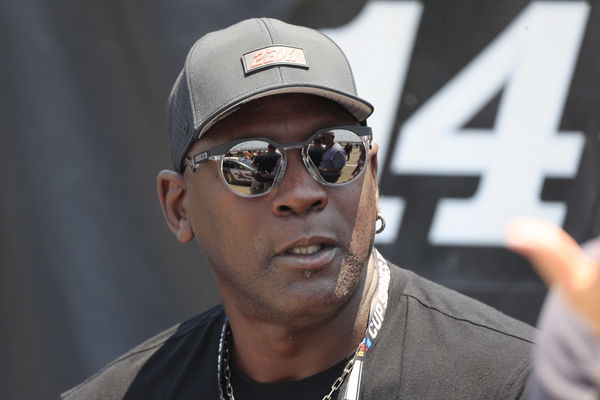
via Getty
NASHVILLE, TN – JUNE 24: Team 23Xi co-owner Michael Jordan on pit road prior to qualifying for the NASCAR Cup Series Ally 400 on June 24, 2023 at Nashville SuperSpeedway in Lebanon, TN. (Photo by Jeff Robinson/Icon Sportswire via Getty Images)

via Getty
NASHVILLE, TN – JUNE 24: Team 23Xi co-owner Michael Jordan on pit road prior to qualifying for the NASCAR Cup Series Ally 400 on June 24, 2023 at Nashville SuperSpeedway in Lebanon, TN. (Photo by Jeff Robinson/Icon Sportswire via Getty Images)
Whenever someone looks at the iconic Jumpman logo, they are reminded of the legendary Michael Jordan. Almost 4 decades since its conception, it has now become synonymous with basketball royalty, so much so that it is earning nearly $7 billion in annual revenue with sales across every global region in which Nike operates. But did you know the logo wasn’t truly a Nike creation?
Well, at least not in the eyes of the photographer who met a young Michael Jordan while still at the University of North Carolina. A 22-minute documentary dubbed JUMPMAN premiered on June 7 at the ongoing Tribeca Film Festival, which unraveled the original controversy behind just how the Jordan pose came to be. “I didn’t take the picture. I made the picture,” Dutch photographer Jacobus ‘Co’ Rentmeester said in the documentary, as per sneaker enthusiast Nick DePaula’s newsletter.
In 1984, Rentmeester traveled to North Carolina as a freelancer for a LIFE Magazine feature photoshoot featuring the player who would be the newest addition to the Bulls roster: Michael Jordan. It was an outdoor shoot setup, and he was given 20 minutes to capture His Airness, wearing New Balance sneakers at the time. Rentmeester asked MJ to perform a “ballet leap,” where MJ had to palm the ball in his left hand and jump towards the ring, splitting his legs. As unconventional as this basketball jump may have been, it sounds familiar, right?
ADVERTISEMENT
Article continues below this ad
That’s because it is. In an article published by LIFE Magazine, they disclosed, “Rentmeester received a request from Nike for two slides from that hillside shoot, to use for presentations only, not reproduction. Nike paid Rentmeester $150 for sending the images out on loan.” The words to focus on here are presentations and loan. However, two months later, the Dutchman got the shock of his life.

via Imago
Michael Jordan – coproprietaire des Charlotte Hornets BASKETBALL : Hornets vs Bucks – NBA, Basketball Herren, USA Paris Game 2020 – 24/01/2020 JBAutissier/Panoramic PUBLICATIONxNOTxINxFRAxITAxBEL
He traveled to Chicago, and owing to Michael Jordan’s booming success as a rookie with the Bulls, he saw his photographic creation right in front of him. On a billboard. The catch? It wasn’t his to claim because, from there on, it had officially become Nike’s – Jordan leaping up and palming the ball in his left hand, leading with his left foot outdoors in front of a sun-setting backdrop. But this time, in red and black Nike gear. “It was like I was hit in the stomach,” Rentmeester recalled in the film. Seeing as the American brand went back on its word, the photographer fought for what was his.
However, instead of giving him credit, Nike gave him $15,000 to use the photo for 2 years. Considering that we still see that same logo, which is affiliated with the Jordan brand, it’s evident that Nike has used it for a lot more than just two years. Other than monetary compensation, Nike promised to hire Rentmeester for future advertising shoots, but that didn’t happen. Rentmeester even went to court in 2014, but his case was dismissed in 2018. The court said that the positioning of Jordan’s right hand was different, and the angle of his body was turned as well.
Since the case never went through a jury, Co Rentmeester decided to take matters into his own hands. With actual pictures from that 1984 photoshoot in Chapel Hill and re-enactments, JUMPMAN is the Dutch photographer’s way to have his story heard and for the public to make up their minds about what happened 40 years ago. After all, he believes he “made that picture,” and “Obviously, [Nike] did not make a picture. They took a picture.”
As Nike and the Jumpman logo are likely to come under intense scrutiny once again, it’s interesting to note that Michael Jordan also had trouble with Air Jordan on the basketball court initially, apart from the logo controversy.
Michael Jordan’s infamous NBA controversy
The Chicago Bulls legend and the brand have been cut above the rest since its inception. Air Jordan 1 started a sneaker revolution that no one expected would boom so much. The colorway of the sneakers was bold black and red, which the NBA did not like. They had a policy of white shoes (they should be at least 51% white) and even fined $5000 every time Jordan wore them on the court. But the publicity and the buzz the banned sneakers created were worth the fine.
In its first year, it almost made $144million, with each pair reportedly priced around $65 at the time. Jordan appeared on the famous David Letterman show, where he was asked about the shoes being banned in his satirical way. Jordan agreed that they were ugly because of the color schemes. The late-night television talk show host asked what was the rule that it was violating. Jordan replied, “Well, it didn’t have any white in it.”
ADVERTISEMENT
Article continues below this ad
Although this light-hearted joke has been squashed, 88-year-old Rentmeester is looking to share his story and the origins of the Jumpman pose through the documentary. Since the documentary is primarily meant for the public, JUMPMAN is expected to be available on a streaming platform soon.
Stay tuned for more such updates, and to follow what Shaq’s ex-agent, Leonard Armato, had to say about the Reese-Clark rivalry and more, watch this video.
ADVERTISEMENT
Article continues below this ad
ADVERTISEMENT
ADVERTISEMENT
ADVERTISEMENT
ADVERTISEMENT

